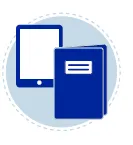Reading Literacy

In the year 2022, the reading literacy of 15-year-old students was assessed as a minor domain in the PISA study. It has been the major domain in 2018, 2009, and at the onset of the PISA study in the year 2000.
In PISA, reading literacy is defined as the ability to understand, use, evaluate, and reflect on texts, as well as being prepared to engage with them in order to achieve one's own goals. According to this definition, reading literacy is the basis for developing one's own knowledge and potential and for participating in society. To meet this broad definition of reading literacy, the PISA test covers different types of texts and tasks at different levels of difficulty.
The reading tasks cover a wide range of text forms, including both continuous texts such as newspaper articles and letters as well as non-continuous texts such as graphs and tables. Information relevant to solving the tasks may be found in a single source or in multiple sources. Since 2018, PISA also contains reading tasks that require students to assess the quality and credibility of textual statements. Additionally, PISA measures the ability to find information by navigating web pages - an important component of digital reading.
In the PISA framework, texts are characterized using the following four dimensions:
Sources:
· single-source texts, e.g. novels, brochures, and pamphlets
· multiple-source texts, e.g. daily newspapers or web pages with articles by different authors and / or publication dates
Organization and navigation:
· static, e.g. in a newspaper article
· dynamic, e.g. on a website
Text formats:
· continuous texts, e.g. essays, novels, and letters
· non-continuous texts, e.g. tables, graphs and timetables
· mixed text forms, e.g. web pages and online forums with continuous and non-continuous elements
Text types:
· description, narration, exposition, argument, instruction, transaction
All texts used for the PISA reading tasks are embedded in a situational context. The framework distinguishes between four different contexts:
· personal contexts, e.g. TV guide, personal e-mails
· public contexts, e.g. menus, timetables
· educational contexts, e.g. textbooks, whiteboard notes
· occupational contexts, e.g. business letters, manuals
In terms of the processes involved in reading, the framework assumes that the following sub-skills play a key role in reading literacy:
· reading fluently
· locating information
· understanding texts
· evaluating and reflecting
In addition, there are cognitive processes related to task management, such as setting a reading goal and monitoring it.
The difficulty of the tasks is composed of the skills required to solve them and the specific characteristics of the text. For example, locating a specific piece of information from a single-source text tends to be easier than a task that requires assembling different pieces of information from multiple text sources.
Sample reading literacy test questions can be found here.